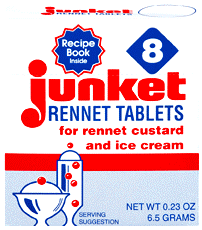Rennet

Substance containing rennin, an enzyme having the property of clotting, or curdling, milk. It is used in the making of cheese and junket.
Rennet is obtained from the stomachs of young mammals living on milk, especially from the inner lining of the fourth, or true, stomach (abomasum) of milk-fed calves.
The preparation of rennet was formerly a part of the domestic function of making cheese; the inner membrane was kept in salt, dried, and, when rennet was needed, soaked in water. Now extract of rennet is made and sold
commercially.
It is usually prepared by soaking the tissues in warm, slightly salted water and straining and preserving the resulting liquid.
Heat interferes with the action of rennet.
Instructions:
Cheese is made by coagulating milk to give curds, which are then separated from the liquid, whey, after which they can be processed and matured to produce a wide variety of cheeses. Milk is coagulated by the addition of rennet. The active ingredient of rennet is the enzyme, chymosin (also known as rennin). Rennet can also be derived from either fungal or bacterial sources. Advances in genetic engineering processes means they may now also be made using chymosin produced by genetically altered micro-organisms.
I found it quite interresting that back in the days, my papou in Greece used old-world techniques to make feta. When they would slaughter a calf for food, my papou would save the calf’s stomach, which would have milk in it. What he would do is hang the stomach and let it dry. What would happen is that the naturally existing rennet would react with the milk in the stomach to make a starter (mayia), and would be mixed with milk to make feta cheese.

